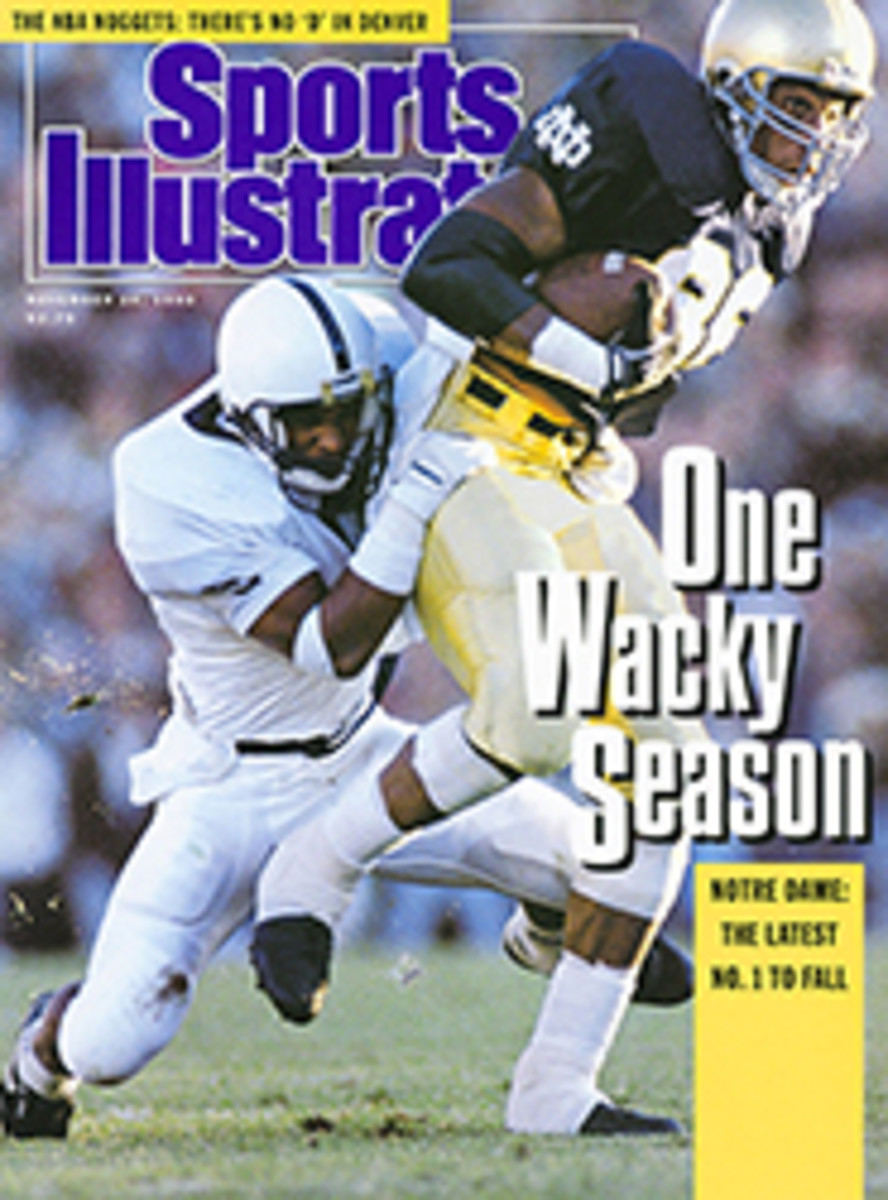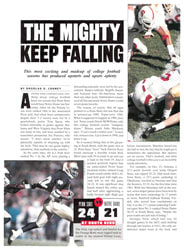
TRUE GRIT
Steffi Graf Slouched unhappily in defeat. Monica Seles dithered gaily and found herself lost in Bloomingdale's. Martina Navratilova lay crablike on her back in a hospital bed two time zones away, and Gabriela Sabatini punched at the air. These were the various attitudes struck last week during the Virginia Slims Championships at Madison Square Garden, a captivating sprawl of a tournament that perfectly summed up an engaging year in women's tennis. Seles's victory over Sabatini in a historic five-set final on Sunday demonstrated that the two women could endure three hours and 47 minutes of arm-bending play and affirmed Seles's new status as No. 2 in the world. Who was No. 1? Suddenly, it was arguable. "Wait," Seles said. "I'm not used to No. 2 yet."
It was fitting that a year in which the four Grand Slam titles were divided among four players ended with a tournament marked by such engrossing havoc. On Nov. 9, three days before the competition was to begin, Wimbledon titlist Navratilova withdrew from the 16-player field to undergo arthroscopic surgery on her 34-year-old knees. Then No. 1-ranked Graf, whose only Grand Slam victory came at the Australian Open, way back in January, suffered her second loss to Sabatini in their last four meetings, falling 6-4, 6-4 in a match that underscored the emotional and physical distress Graf endured throughout the year. Finally, the whole affair concluded with an unnerving shriek from Seles, the French Open champion, as she buried one last backhand winner deep into a corner to defeat Sabatini, the U.S. Open champ, 6-4, 5-7, 3-6, 6-4, 6-2 in the first women's five-set match in 89 years. "I was getting really hungry," Seles said afterward. "I didn't eat any lunch."
That neither Graf nor Navratilova was in the finals bespoke the new health and depth of women's tennis, which only a year ago seemed on the verge of being suffocated in the merciless hold of Graf, who won the Grand Slam in 1988 and has held the top ranking since August 1987. Going into this year, Graf had collected seven of the last eight Grand Slam titles and showed no sign of relenting. Instead, 1990 will be remembered for its upsets, mishaps, intrigue—and even for its riveting tennis. Despite her defeat in New York, Graf will not relinquish the No. 1 spot on the computer, but all due respect must be given to Seles, a kooky 16-year-old with a catchy, staccato laugh and the competitive heart and biting strokes of a rattlesnake.
Seles could make a claim to No. 1 based on victories over Graf in their only two meetings this year, including in the French Open final. Seles was also 3-1 against Navratilova, whom she replaced at No. 2 in the rankings on Saturday with a 6-3, 6-4 win over the fourth-ranked Mary Joe Fernandez in the semis. On the other hand, Seles's 54-6 match record for 1990 was second to Graf's 72-5 mark. Seles won nine tournaments and $1.63 million in prize and bonus money. Graf won 10 titles and $1.91 million. For what it's worth, Seles was also the first woman to win a five-set match since Elizabeth Moore beat Myrtle McAteer to win the U.S. Nationals in Philadelphia in 1901.
Few would have believed that as Sunday's finalists went the distance—an occasion that had been awaited since 1984, when this tournament adopted the five-set format for the final—Seles could raise her game to a higher level of otherworldly shrieks after falling behind two sets to one. Finding the last of her stamina in her slender backbone, she committed only six unforced errors and thrashed 28 winners in the fourth and fifth sets. "I don't know why—it is very strange—but I am pretty much like that mentally," she said. "The longer I keep going, I am not as tired."
To hear Seles tell it, her misadventure in Bloomingdale's earlier in the week was more trying. For 90 minutes she wandered the cavernous midtown department store looking for her parents, Karolj and Esther. "It's not like the Sarasota mall," said Seles, who four years ago moved from Yugoslavia to Florida. "It's crazy. I kept going around and around." Finally, after several pages over the store's loudspeaker and much confusion, the Seleses were reunited. "It was a very long day," she said.
As for the quality of play in the final, while it was generally high, Seles and Sabatini demonstrated that a five-setter can outlast its entertainment value. The points bore a dulling sameness: Seles flailing from the baseline with her two-fisted strokes from both sides, Sabatini alternately looping her topspin drives and lunging for touch volleys. Seles finally got the upper hand by attacking Sabatini's short, vulnerable second serve. She won 44 of the match's 66 points that started with Sabatini's second delivery.
Seles broke serve in the fourth game of the deciding set, and Sabatini never recovered. Leading 5-2, Seles lashed a Sabatini second serve down the line for a winner to reach double match point. Seles then won the title with a sharp combination: She planted Sabatini in the corner with a down-the-line forehand return, swung her in the other direction with a crosscourt backhand and finished her off with a scathing, second cross-court backhand back to the opposite corner.
Seles had not played Sabatini in 32 months. In that time, Seles (now 5'9", 120 pounds) has grown six inches and gained 30 pounds. No wonder Sabatini said she was taken aback by Seles's power in the final. "I was surprised at the way she hit the ball," Sabatini said. "She hits the ball very, very hard."
Sabatini has undergone a metamorphosis too, having overhauled her game in less than six months this year under a new coach, Carlos Kirmayr of Brazil. Formerly an unimaginative topspin artist, she has become lighter on her feet and has developed into an aggressive, lyrical shot-maker with a surprisingly deft touch at the net. But she remains as painfully laconic as ever. "I think I am just putting everything in my game together," Sabatini said.
Her timing is impeccable. After suffering an early-round loss to 15th-ranked Jana Novotna at the French Open—it was that defeat that prompted her to hire Kirmayr—Sabatini was generally written off as being incapable of challenging Graf's supremacy. Since then, though, she has come closer than either Seles or Graf to possessing a complete game, and has even become a lively presence on the court, often buoying herself with deep grunts and air jabs. The second serve is Sabatini's one remaining weakness.
Graf was given pause by Sabatini's near flawless play in the semis. Graf built a 3-0 lead, but Sabatini came close to dominating her the rest of the way. Graf still has a 20-5 career record against Sabatini, but Saturday's result, coupled with Sabatini's victory over Graf in the finals at Flushing Meadow, proves that the long-awaited rivalry between these two has finally come to fruition. Graf conceded as much, saying, "Her kind of game is making things difficult, and she knows it now."
Ultimately, 1990 will be remembered as much for Graf's travails as for the growing threats posed by Seles and Sabatini. Graf's year-end state of mind became evident when she called Navratilova shortly before her operation to offer her good wishes. It was the sort of gesture Graf had never before extended to Navratilova. "Who?" Navratilova said in shock as she answered the phone.
On Nov. 11 noted orthopedic surgeon Dr. Richard Steadman performed an hour-long arthroscopic procedure at the Vail (Colo.) Valley Medical Center to correct tendinitis and remove calcium deposits in both of Navratilova's knees. Navratilova will undergo six to eight weeks of rehabilitation that could buy her three or four more competitive years on the tour. "I've had a sprained ankle that hurt worse," she said after the surgery.
It's understandable that Graf would have compassion for anyone in pain. She has endured this year, in order, a broken thumb on her right hand in a freak skiing accident in February, an agonizing sinus condition through much of the spring that required surgery after Wimbledon, and persistent tabloid reports of the liaison between her father, Peter, and Playboy model Nicole Meissner. In the latest twist in this saga, Peter recently was ordered to take a blood test to help determine if he is the father of Meissner's daughter.
On Nov. 13, during her stirring 6-3, 5-7, 6-3 opening-round victory over 14-year-old Jennifer Capriati, Steffi was stricken with gastritis, for which a trainer at courtside administered an antacid. The week before the Slims, Graf had won a tournament while suffering from the flu. "I've had a very, very difficult year," Graf said following the tournament. "I don't think they can come more difficult than this. I probably learned a lot. Much more than I ever wanted to."
At times this year she was an obviously vulnerable young woman. During the U.S. Open she took a tour official's dog for a walk because she missed her own pets. Last week she asked if the same pooch was still in New York. She recently bought a gold band for her wedding finger to symbolize a new sense of self-reliance. Tabloids in Europe seized on the purchase (I WAS SO UNHAPPY I 'MARRIED' MYSELF cried the Daily Express), and she now cringes at the mere mention of the subject. "I buy a ring and everybody makes a big deal," she said. "I just liked it. That's just an example of how...I mean, what can you do?"
More guarded and yet, paradoxically, more openly sensitive than she used to be, Graf promised not to endure the misery of 1990 ever again, even if it means taking her sport less seriously. "I always knew tennis was not everything for me," she said. "But I learned it's not important compared to many, many things. That's why I think maybe I'm going to take it easy next year. I'm just going to enjoy it. I'm actually looking very much forward to it. I'm going to get into it, and I'm going to be much more relaxed."
However, that should not be taken to mean Graf has lost her ambition. That she was shaken and angered by last week's loss to Sabatini became evident when she was asked in a postmatch press conference whether she still considered herself No. 1. "You are laughing," Graf said. "You like to ask that question, right?"
"I don't like to," replied the scribe.
"Oh yeah? Come on, don't give me that," Graf said. "Come on, now. You can write whatever you want. You can say whatever you want. I know what I feel like."
Graf most emphatically feels like No. 1. Despite her difficulties this year, she never failed to reach at least the semifinals of a tournament and did not lose to anyone ranked below No. 5. "The good thing is that there were times when I really brought myself through, even though I was having such a tough year," she said. "I found out a lot about myself."
As for next year, Graf will seek some peace, Navratilova will pursue her 10th Wimbledon title, and Sabatini will try to find that last missing piece of her game. And Seles? The logical progression would be to No. 1. But she cannot quite place herself there yet in the face of Graf's steadfastness. "I mean, I don't know," Seles said on Sunday. "It's hard. I would probably come close."
She may come closer still.
PHOTO
MANNY MILLAN
PHOTO
MANNY MILLAN
Sabatini knocked off Graf but was done in by a hungry Seles.
TWO PHOTOS
MANNY MILLAN
Graf's gold band symbolizes her new feeling of self-reliance, but her year ended on an ill note.

